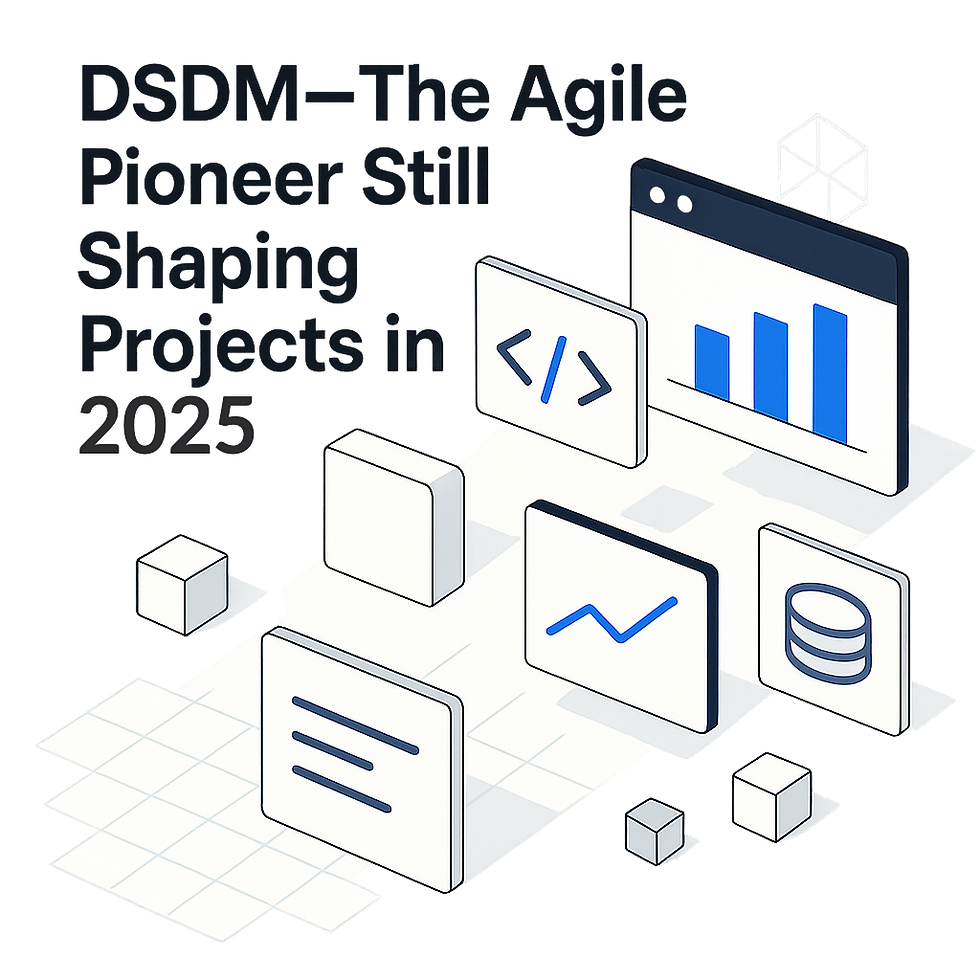DSDM—The Agile Pioneer Still Shaping Projects in 2025
- Krzysztof Kosman

- Aug 15
- 4 min read

Is 'Old School' Agile Making a Comeback?
While many teams eagerly chase shiny, new frameworks—think SAFe, LeSS, or Spotify—the roots of agile remain quietly powerful. One such root system, DSDM (Dynamic System Development Method), is experiencing a digital renaissance.
With project managers, EdTech startups, and software houses searching for frameworks that balance speed with structure, DSDM stands out as a robust, full-lifecycle agile methodology.
So, why does DSDM matter now, and what can it teach us about sustainable agility in education, digital transformation, and software development?
The Changing Tides: Why DSDM Matters in the Agile Era
Agile is no longer just a set of rituals for developer teams; it is the backbone of modern digital organizations. The pandemic-induced remote revolution, the rise of interdisciplinary teams, and the pressure to adapt education, government, and healthcare systems have reignited debates about the best agile approaches.
DSDM, first introduced in 1994 as a disciplined response to Rapid Application Development’s chaos, has always advocated business-aligned agility. According to the Agile Business Consortium, DSDM remains vendor-independent, focuses on early business value, and scales to suit all project types and sizes. But its true renaissance comes from a world tired of cargo cult agile—where sticky notes and daily standups hide a lack of delivery rigor.
Take, for example, a major European university’s EdTech upgrade project. They initially attempted Scrum but struggled with vague goals, shifting stakeholder engagement, and mounting technical debt. Switching to a DSDM approach, with its strict principles and iterative governance, delivered clarity and real, early benefits.
This combination of agility and discipline is precisely why DSDM stories dominate search trends today.
Cracking the DSDM Code: 4 Timeless Principles for Modern Teams
1. Alignment Before Action: Focus on Business Need
“It’s not enough to build the right thing fast; you have to know what matters,” says a seasoned DSDM practitioner in an interview with Smartsheet. DSDM projects begin with defined, measurable business goals. This translates to education technology where new platforms or learning management systems must prove their value from the get-go, not in a distant MVP phase.
For example, EdTech company Knewton used DSDM-inspired business focus to transform a sprawling project into a value-driven platform, quickly iterating on features proven to boost classroom engagement. The early delivery of actionable analytics encouraged stakeholder buy-in and continuous improvement.
2. Structure Powers Speed: The Eight DSDM Principles
Focus on the business need
Deliver on time
Collaborate
Never compromise quality
Build incrementally from firm foundations
Develop iteratively
Communicate continuously and clearly
Demonstrate control
Rather than slowing things down, these principles enable teams to move faster. For growing digital schools and universities, this means less firefighting and fewer failed rollouts.
Agile Business Consortium emphasizes that these principles are a safety net, not a straightjacket. For instance, "Prioritisation using MoSCoW" (Must have, Should have, Could have, Won't have) gives clarity when budgets or timelines get squeezed—a reality for most education IT projects.
3. Iterate, Model, and Prioritize—DSDM’s Best Practices in Action
According to Smartsheet’s exhaustive breakdown, DSDM champions facilitated workshops, prototyping, rigorous timeboxing, and MoSCoW prioritization. EdTech and enterprise teams alike have realized that:
Timeboxing: Embeds deadlines for definable chunks—not the whole project—preventing scope creep and perpetual pre-launch iterations.
MoSCoW: Clearly articulates "must haves" versus “nice-to-haves”—especially vital when grant funding drives project scope in public education.
Iterative Development: Delivers real, testable features early, which is crucial in fast-moving classrooms or teacher training programs.
These processes are why DSDM has survived in sectors that demand evidence—such as government, health, and education—where unchecked agility often stumbles.
4. Collaboration (for Real) and Vendor Independence
In DSDM, collaboration goes beyond team rituals. Stakeholder engagement is expected and formalized at each phase, whether for a new math curriculum app or a city-wide learning management revamp. This involvement reduces resistance to change—a notorious project killer.
Furthermore, DSDM’s vendor-independent approach means it can dovetail with frameworks like PRINCE2 or Scrum, adapting to realities on the ground. For education IT teams juggling legacy platforms and cutting-edge tools, this flexibility is a lifeline.
Where DSDM Fits in Today’s Turbulent Tech Culture
The trends are clear: digital transformation is accelerating in education, and organizations are seeking frameworks that balance speed, adaptability, and traceability. DSDM offers practical answers where other agile methods sometimes rely on cultural magic alone. Consider Gartner’s 2023 warning about over-ambitious agile transformations—“without discipline and robust prioritization, agile projects often flounder."
For startups and universities alike, the message is: don’t be seduced by trends alone. Choose the method (or blend of methods) that keeps projects grounded in business value and can show early results without burning out teams or budgets.
So, What Now? Some Takeaways and Next Steps
Revisit DSDM’s Eight Principles for project kickoffs—could your roadmap benefit from this built-in alignment?
MoSCoW Prioritization: Bring it into backlog discussions, especially in contexts where resources are contested.
Mix and Match Frameworks, But Deliberately: Use DSDM to inject rigor and full-lifecycle thinking alongside experimental pilots.
Emphasize Early Delivery of Real Value, not just MVP demos. What’s the tangible improvement for the student, teacher, or end-user?
Educate Your Stakeholders Early: Collaboration isn’t a ceremony—it’s a contract.
Further reading? Dive into real-world case studies at the Agile Business Consortium or experiment with DSDM-aligned templates to see the difference first-hand.
Wrapping Up: DSDM Is Not Dead—It’s Evolving
Despite the noisy evolution of agile, DSDM’s DNA quietly drives some of the world’s most successful, risk-managed projects. The education sector—hungry for fast, reliable improvement—can draw immense value from its principles, especially as it navigates digital transformation and complex stakeholder webs.
If you’re a product owner, digital leader, or instructional designer, ask yourself: Could your next project use a dose of business alignment, structured collaboration, and value-driven iteration?
In a world swamped by agile jargon, perhaps DSDM’s measured, business-oriented approach is the smart way forward. What’s your next step?


